Archery



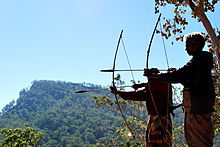

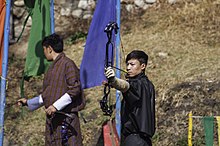

Archery is the sport, practice, or skill of using a bow to shoot arrows.[1] The word comes from the Latin arcus, meaning bow.[2] Historically, archery has been used for hunting and combat. In modern times, it is mainly a competitive sport and recreational activity. A person who practices archery is typically called an archer, bowman, or toxophilite.[3]
History
Origins and ancient archery
The oldest known evidence of the bow and arrow comes from South African sites such as Sibudu Cave, where the remains of bone and stone arrowheads have been found dating approximately 72,000 to 60,000 years ago.[4][5][6][7][8][9] Based on indirect evidence, the bow also seems to have appeared or reappeared later in Eurasia, near the transition from the Upper Paleolithic to the Mesolithic. The earliest definite remains of bow and arrow from Europe are possible fragments from Germany found at Mannheim-Vogelstang dated 17,500 to 18,000 years ago, and at Stellmoor dated 11,000 years ago. Azilian points found in Grotte du Bichon, Switzerland, alongside the remains of both a bear and a hunter, with flint fragments found in the bear's third vertebra, suggest the use of arrows at 13,500 years ago.[10] Other signs of its use in Europe come from the Stellmoor in the Ahrensburg valley north of Hamburg, Germany and dates from the late Paleolithic, about 10,000–9000 BC. The arrows were made of pine and consisted of a main shaft and a 15–20 cm (5.9–7.9 in) fore shaft with a flint point. There are no definite earlier bows; previous pointed shafts are known, but may have been launched by spear-throwers rather than bows. The oldest bows known so far comes from the Holmegård swamp in Denmark. At the site of Nataruk in Turkana County, Kenya, obsidian bladelets found embedded in a skull and within the thoracic cavity of another skeleton, suggest the use of stone-tipped arrows as weapons about 10,000 years ago.[11] Bows eventually replaced the
Bows and arrows have been present in
Archery was highly developed in Asia. The Sanskrit term for archery, dhanurvidya, came to refer to martial arts in general. In East Asia, Goguryeo, one of the Three Kingdoms of Korea was well known for its regiments of exceptionally skilled archers.[17][18]
Medieval archery
The medieval shortbow was technically identical with the classical era bows, having a range of approximately 91 m (299 ft). It was the primary ranged weapon of the battlefield through the early medieval period. Around the tenth century the crossbow was introduced in Europe. Crossbows generally had a longer range, greater accuracy and more penetration than the shortbow, but suffered from a much slower rate of fire. Crossbows were used in the early Crusades, with models having a range of 274 m (899 ft) and being able to penetrate armour or kill a horse.[19]
During the late medieval period the English army famously relied on massed archers armed with the
becoming part of military lore.Mounted archery
Decline of archery
The development of
18th century revival as a sport
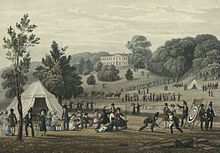
Early recreational archery societies included the Finsbury Archers and the Ancient Society of Kilwinning Archers. The latter's annual Papingo event was first recorded in 1483. (In this event, archers shoot vertically from the base of an abbey tower to dislodge a wood pigeon placed approximately 30 m (98 ft) above.)[30] The Royal Company of Archers was formed in 1676 and is one of the oldest sporting bodies in the world.[31] Archery remained a small and scattered pastime, however, until the late 18th century when it experienced a fashionable revival among the aristocracy. Sir Ashton Lever, an antiquarian and collector, formed the Toxophilite Society in London in 1781, with the patronage of George, the Prince of Wales.
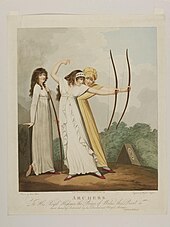
Archery societies were set up across the country, each with its own strict entry criteria and outlandish costumes. Recreational archery soon became extravagant social and ceremonial events for the nobility, complete with flags, music and
After the Napoleonic Wars, the sport became increasingly popular among all classes, and it was framed as a nostalgic reimagining of the preindustrial rural Britain. Particularly influential was Sir Walter Scott's 1819 novel, Ivanhoe that depicted the heroic character Lockseley winning an archery tournament.[33]

A modern sport
The 1840s saw the second attempts at turning the recreation into a modern sport. The first

Towards the end of the 19th century, the sport experienced declining participation as alternative sports such as
The National Archery Association of the United States was organized in 1879, in part by Maurice Thompson[37] (the author of the seminal text “The Witchery of Archery”) and his brother Will Thompson. Maurice was president in its inaugural year and Will was president in 1882, 1903, and 1904.[38] The 1910 President was Frank E Canfield.[39] Today it is known as USA Archery and is recognized by United States Olympic & Paralympic Committee.[40]
In the United States, primitive archery was revived in the early 20th century. The last of the

From the 1920s, professional engineers took an interest in archery, previously the exclusive field of traditional craft experts.[45] They led the commercial development of new forms of bow including the modern recurve and compound bow. These modern forms are now dominant in modern Western archery; traditional bows are in a minority. Archery returned to the Olympics in 1972. In the 1980s, the skills of traditional archery were revived by American enthusiasts, and combined with the new scientific understanding. Much of this expertise is available in the Traditional Bowyer's Bibles (see Further reading). Modern game archery owes much of its success to Fred Bear, an American bow hunter and bow manufacturer.[46]
In 2021, five people were killed and three injured by an archer in Norway in the Kongsberg attack.[47]
Mythology
Deities and heroes in several mythologies are described as archers, including the Greek
The Nymphai Hyperboreioi (Νύμφαι Ὑπερβόρειοι) were worshipped on the Greek island of Delos as attendants of Artemis, presiding over aspects of archery; Hekaerge (Ἑκαέργη), represented distancing, Loxo (Λοξώ), trajectory, and Oupis (Οὖπις), aim.[50]
In
Equipment
Types of bows

While there is great variety in the construction details of bows (both historical and modern), all bows consist of a string attached to elastic limbs that store mechanical energy imparted by the user drawing the string. Bows may be broadly split into two categories: those drawn by pulling the string directly and those that use a mechanism to pull the string.
Directly drawn bows may be further divided based upon differences in the method of limb construction, notable examples being
In different cultures, the arrows are released from either the left or right side of the bow, and this affects the hand grip and position of the bow. In Arab archery, Turkish archery, and Japanese archery. The arrows are released from the right hand side of the bow, and this affects construction of the bow. In western archery, the arrow is usually released from the left hand side of the bow for a right-handed archer.

Compound bows are designed to reduce the force required to hold the string at full draw, hence allowing the archer more time to aim with less muscular stress. Most compound designs use cams or elliptical wheels on the ends of the limbs to achieve this. A typical let-off is anywhere from 65% to 80%. For example, a 27 kg (60 lb) bow with 80% let-off only requires 53 N (12 lbf) to hold at full draw. Up to 99% let-off is possible.[54] The compound bow was invented by Holless Wilbur Allen in the 1960s (a US patent was filed in 1966 and granted in 1969) and it has become the most widely used type of bow for all forms of archery in North America.
Mechanically drawn bows typically have a stock or other mounting, such as the crossbow. Crossbows typically have shorter draw lengths compared to compound bows. Because of this, heavier draw weights are required to achieve the same energy transfer to the arrow. These mechanically drawn bows also have devices to hold the tension when the bow is fully drawn. They are not limited by the strength of a single archer and larger varieties have been used as siege engines.
Types of arrows and fletchings
The most common form of arrow consists of a
The arrowhead is the primary functional component of the arrow. Some arrows may simply use a sharpened tip of the solid shaft, but separate arrowheads are far more common, usually made from metal, stone, or other hard materials. The most commonly used forms are target points, field points, and broadheads, although there are also other types, such as bodkin, judo, and blunt heads.
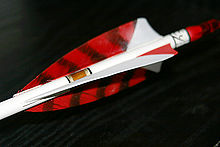
Fletching is traditionally made from bird feathers, but solid plastic vanes and thin sheet-like spin vanes are used. They are attached near the nock (rear) end of the arrow with thin double sided tape, glue, or, traditionally, sinew. The most common configuration in all cultures is three fletches, though as many as six have been used. Two makes the arrow unstable in flight. When the arrow is three-fletched, the fletches are equally spaced around the shaft, with one placed such that it is perpendicular to the bow when nocked on the string, though variations are seen with modern equipment, especially when using the modern spin vanes. This fletch is called the "index fletch" or "cock feather" (also known as "the odd vane out" or "the nocking vane"), and the others are sometimes called the "hen feathers". Commonly, the cock feather is of a different color. However, if archers are using fletching made of feather or similar material, they may use same color vanes, as different dyes can give varying stiffness to vanes, resulting in less precision. When an arrow is four-fletched, two opposing fletches are often cock feathers, and occasionally the fletches are not evenly spaced.
The fletching may be either parabolic cut (short feathers in a smooth parabolic curve) or shield cut (generally shaped like half of a narrow shield), and is often attached at an angle, known as helical fletching, to introduce a stabilizing spin to the arrow while in flight. Whether helical or straight fletched, when natural fletching (bird feathers) is used it is critical that all feathers come from the same side of the bird. Oversized fletchings can be used to accentuate drag and thus limit the range of the arrow significantly; these arrows are called flu-flus. Misplacement of fletchings can change the arrow's flight path dramatically.
Bowstring
Protective equipment
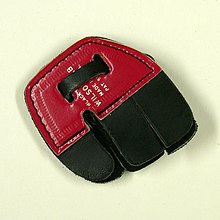
Most modern archers wear a
The drawing digits are normally protected by a leather tab, glove, or thumb ring. A simple tab of leather is commonly used, as is a skeleton glove. Medieval Europeans probably used a complete leather glove.[59]
Eurasiatic archers who used the thumb or Mongolian draw protected their thumbs, usually with leather according to the author of Arab Archery,
Release aids
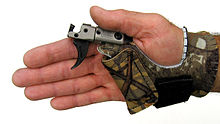
A release aid is a mechanical device designed to give a crisp and precise loose of arrows from a compound bow. In the most commonly used, the string is released by a finger-operated trigger mechanism, held in the archer's hand or attached to their wrist. In another type, known as a back-tension release, the string is automatically released when drawn to a pre-determined tension.
Stabilizers
Stabilizers are mounted at various points on the bow. Common with competitive archery equipment are special brackets that allow multiple stabilizers to be mounted at various angles to fine tune the bow's balance.
Stabilizers aid in aiming by improving the balance of the bow. Sights, quivers, rests, and design of the riser (the central, non-bending part of the bow) make one side of the bow heavier. One purpose of stabilizers are to offset these forces. A reflex riser design will cause the top limb to lean towards the shooter. In this case a heavier front stabilizer is desired to offset this action. A deflex riser design has the opposite effect and a lighter front stabilizer may be used.
Stabilizers can reduce noise and vibration. These energies are absorbed by viscoelastic polymers, gels, powders, and other materials used to build stabilizers.
Stabilizers improve the forgiveness and accuracy by increasing the moment of inertia of the bow to resist movement during the shooting process. Lightweight carbon stabilizers with weighted ends are desirable because they improve the moment of inertia while minimizing the weight added.
Shooting technique and form

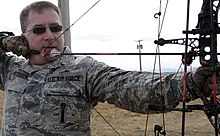
The standard convention on teaching archery is to hold the bow depending upon eye dominance.[62] (One exception is in modern kyūdō where all archers are trained to hold the bow in the left hand.)[63] Therefore, if one is right-eye dominant, they would hold the bow in the left hand and draw the string with the right hand. However, not everyone agrees with this line of thought. A smoother, and more fluid release of the string will produce the most consistently repeatable shots, and therefore may provide greater accuracy of the arrow flight. Some believe that the hand with the greatest dexterity should therefore be the hand that draws and releases the string. Either eye can be used for aiming, and the less dominant eye can be trained over time to become more effective for use. To assist with this, an eye patch can be temporarily worn over the dominant eye.
The hand that holds the bow is referred to as the bow hand and its arm the bow arm. The opposite hand is called the drawing hand or string hand. Terms such as bow shoulder or string elbow follow the same convention.
If shooting according to eye dominance, right-eye-dominant archers shooting conventionally hold the bow with their left hand. If shooting according to hand dexterity, the archer draws the string with the hand that possesses the greatest dexterity, regardless of eye dominance.
Modern form
To shoot an arrow, an archer first assumes the correct stance. The body should be at or nearly perpendicular to the target and the shooting line, with the feet placed shoulder-width apart. As an archer progresses from beginner to a more advanced level other stances such as the "open stance" or the "closed stance" may be used, although many choose to stick with a "neutral stance". Each archer has a particular preference, but mostly this term indicates that the leg furthest from the shooting line is a half to a whole foot-length from the other foot, on the ground.
To load, the bow is pointed toward the ground, tipped slightly clockwise of vertical (for a right handed shooter) and the shaft of the arrow is placed on the arrow rest or shelf. The back of the arrow is attached to the bowstring with the nock (a small locking groove located at the proximal end of the arrow). This step is called "nocking the arrow". Typical arrows with three vanes should be oriented such that a single vane, the "cock feather", is pointing away from the bow, to improve the clearance of the arrow as it passes the arrow rest.
A compound bow is fitted with a special type of arrow rest, known as a launcher, and the arrow is usually loaded with the cock feather/vane pointed either up, or down, depending upon the type of launcher being used.
The bowstring and arrow are held with three fingers, or with a mechanical arrow release. Most commonly, for finger shooters, the index finger is placed above the arrow and the next two fingers below, although several other techniques have their adherents around the world, involving three fingers below the arrow, or an arrow pinching technique. Instinctive shooting is a technique eschewing sights and is often preferred by traditional archers (shooters of longbows and recurves). In either the split finger or three finger under case, the string is usually placed in the first or second joint, or else on the pads of the fingers. When using a mechanical release aid, the release is hooked onto the D-loop.[64]
Another type of string hold, used on traditional bows, is the type favoured by the Mongol warriors, known as the "thumb release", style. This involves using the thumb to draw the string, with the fingers curling around the thumb to add some support. To release the string, the fingers are opened out and the thumb relaxes to allow the string to slide off the thumb. When using this type of release, the arrow should rest on the same side of the bow as the drawing hand i.e. Left hand draw = arrow on left side of bow.
The archer then raises the bow and draws the string, with varying alignments for vertical versus slightly canted bow positions. This is often one fluid motion for shooters of recurves and longbows, which tend to vary from archer to archer. Compound shooters often experience a slight jerk during the drawback, at around the last 4 cm (1.6 in), where the draw weight is at its maximum—before relaxing into a comfortable stable full draw position. The archer draws the string hand towards the face, where it should rest lightly at a fixed anchor point. This point is consistent from shot to shot, and is usually at the corner of the mouth, on the chin, to the cheek, or to the ear, depending on preferred shooting style. The archer holds the bow arm outwards, toward the target. The elbow of this arm should be rotated so that the inner elbow is perpendicular to the ground, though archers with hyper extendable elbows tend to angle the inner elbow toward the ground, as exemplified by the Korean archer
In modern form, the archer stands erect, forming a "T". The archer's lower
The arrow is typically released by relaxing the fingers of the drawing hand (see bow draw), or triggering the mechanical release aid. Usually the release aims to keep the drawing arm rigid, the bow hand relaxed, and the arrow is moved back using the back muscles, as opposed to using just arm motions. An archer should also pay attention to the recoil or follow through of his or her body, as it may indicate problems with form (technique) that affect accuracy.
Aiming methods
This section needs additional citations for verification. (March 2011) |

There are two main forms of aiming in archery: using a mechanical or fixed sight, or barebow.
Mechanical sights can be affixed to the bow to aid in aiming. They can be as simple as a pin, or may use optics with magnification. Modern compound bows usually also have a peep sight (rear sight) built into the string, which aids in a consistent anchor point, but this is not allowed for other bow types under World Archery. Modern compound[65] bows automatically limit the draw length to give a consistent arrow velocity, while traditional bows allow great variation in draw length. Some bows use mechanical methods to make the draw length consistent. Barebow archers often use a sight picture, which includes the target, the bow, the hand, the arrow shaft and the arrow tip, as seen at the same time by the archer. With a fixed "anchor point" (where the string is brought to, or close to, the face), and a fully extended bow arm, successive shots taken with the sight picture in the same position fall on the same point. This lets the archer adjust aim with successive shots to achieve accuracy.
Modern archery equipment usually includes sights. Instinctive aiming is used by many archers who use traditional bows. The two most common forms of a non-mechanical release are split-finger and three-under. Split-finger aiming requires the archer to place the index finger above the nocked arrow, while the middle and ring fingers are both placed below. Three-under aiming places the index, middle, and ring fingers under the nocked arrow. This technique allows the archer to better look down the arrow since the back of the arrow is closer to the dominant eye, and is commonly called "gun barreling" (referring to common aiming techniques used with firearms).
When using short bows or shooting from horseback, it is difficult to use the sight picture. The archer may look at the target, but without including the weapon in the field of accurate view. Aiming then involves hand-eye coordination—which includes proprioception and motor-muscle memory, similar to that used when throwing a ball. With sufficient practice, such archers can normally achieve good practical accuracy for hunting or for war.[66] Aiming without a sight picture may allow more rapid shooting, not however increasing accuracy.
Instinctive shooting
Instinctive shooting is a style of shooting that includes the barebow aiming method that relies heavily upon the subconscious mind, proprioception, and motor/muscle memory to make aiming adjustments; the term used to refer to a general category of archers who did not use a mechanical or fixed sight.[67] In other words, it is shooting "by feel."[68]
Gap shooting
Gap shooting is an aiming method used by instinctive shooters.[69] It involves consciously focusing on the tip of the arrow while maintaining awareness of the target. The archer must adjust the arrow's trajectory by gauging the distance between the arrow tip and the target, ensuring accurate shots.[69]
Physics
When a projectile is thrown by hand, the speed of the projectile is determined by the kinetic energy imparted by the thrower's muscles performing work. However, the energy must be imparted over a limited distance (determined by arm length) and therefore (because the projectile is accelerating) over a limited time, so the limiting factor is not work but rather power, which determines how much energy can be added in the limited time available. Power generated by muscles, however, is limited by force–velocity relationship, and even at the optimal contraction speed for power production, total work by the muscle is less than half of what it would be if the muscle contracted over the same distance at slow speeds, resulting in less than 1/4 the projectile launch velocity possible without the limitations of the force–velocity relationship.
When a bow is used, the muscles are able to perform work much more slowly, resulting in greater force and greater work done. This work is stored in the bow as
Even with a release aid mechanism some of this effect is usually experienced, since the string always accelerates faster than the retaining part of the mechanism. This makes the arrow oscillate in flight—its center flexing to one side and then the other repeatedly, gradually reducing as the arrow's flight proceeds. This is clearly visible in high-speed photography of arrows at discharge. A direct effect of these energy transfers can clearly be seen when

Modern arrows are made to a specified 'spine', or stiffness rating, to maintain matched flexing and hence accuracy of aim. This flexing can be a desirable feature, since, when the spine of the shaft is matched to the acceleration of the bow(string), the arrow bends or flexes around the bow and any arrow-rest, and consequently the arrow, and fletchings, have an un-impeded flight. This feature is known as the archer's paradox. It maintains accuracy, for if part of the arrow struck a glancing blow on discharge, some inconsistency would be present, and the excellent accuracy of modern equipment would not be achieved.
The accurate flight of an arrow depends on its fletchings. The arrow's manufacturer (a "fletcher") can arrange fletching to cause the arrow to rotate along its axis. This improves accuracy by evening pressure buildups that would otherwise cause the arrow to "plane" on the air in a random direction after shooting. Even with a carefully made arrow, the slightest imperfection or air movement causes some unbalanced turbulence in air flow. Consequently, rotation creates an equalization of such turbulence, which, overall, maintains the intended direction of flight i.e. accuracy. This rotation is not to be confused with the rapid gyroscopic rotation of a rifle bullet. Fletching that is not arranged to induce rotation still improves accuracy by causing a restoring drag any time the arrow tilts from its intended direction of travel.
The innovative aspect of the invention of the bow and arrow was the amount of power delivered to an extremely small area by the arrow. The huge ratio of length vs. cross sectional area, coupled with velocity, made the arrow more powerful than any other hand held weapon until firearms were invented. Arrows can spread or concentrate force, depending on the application. Practice arrows, for instance, have a blunt tip that spreads the force over a wider area to reduce the risk of injury or limit penetration. Arrows designed to pierce armor in the Middle Ages used a very narrow and sharp tip ("bodkinhead") to concentrate the force. Arrows used for hunting used a narrow tip ("broadhead") that widens further, to facilitate both penetration and a large wound.
Hunting
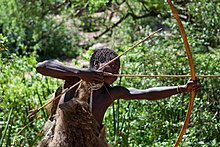

Using archery to take game animals is known as "bow hunting". Bow hunting differs markedly from hunting with firearms, as distance between hunter and prey must be much shorter to ensure a humane kill. The skills and practices of bow hunting therefore emphasize very close approach to the prey, whether by still hunting, stalking, or waiting in a blind or tree stand. In many countries, including much of the United States, bow hunting for large and small game is legal. Bow hunters generally enjoy longer seasons than are allowed with other forms of hunting such as black powder, shotgun, or rifle. Usually, compound bows are used for large game hunting due to the relatively short time it takes to master them as opposed to the longbow or recurve bow. These compound bows may feature fiber optic sights, stabilizers, and other accessories designed to increase accuracy at longer distances. Using a bow and arrow to take fish is known as "
Modern competitive archery
Competitive archery involves shooting arrows at a target for accuracy from a set distance or distances. This is the most popular form of competitive archery worldwide and is called target archery. A form particularly popular in Europe and America is field archery, shot at targets generally set at various distances in a wooded setting. Competitive archery in the United States is governed by USA Archery and National Field Archery Association (NFAA), which also certifies instructors.[71]
Para-archery is an adaptation of archery for athletes with a disability, governed by the
See also
- Arash
- Arab archery
- Archery Association of India
- 3D archery
- Bow draw
- Bowfishing
- Bowhunting
- Clout archery
- Field archery
- Gungdo
- Kyūdō
- Kyūjutsu
- Modern competitive archery
- Mounted archery
- Run archery
- Sagittarii
- Target archery
- Turkish archery
- List of archery terms
- List of notable archers
- Crossbow
References
- ^ Paterson Encyclopaedia of Archery p. 17
- ^ Charlton T. Lewis; Charles Short (1879). "Charlton T. Lewis, Charles Short, A Latin Dictionary, arcus". Charlton T. Lewis, Charles Short, A Latin Dictionary. Oxford. Clarendon Press. Retrieved 23 September 2020.
- ^ The noun "toxophilite", meaning "a lover or devotee of archery, an archer" derives from Toxophilus by Roger Ascham —"imaginary proper name invented by Ascham, and hence title of his book (1545), intended to mean 'lover of the bow'." "toxophilite, n." Oxford English Dictionary. Second edition, 1989; online version November 2010. <http://www.oed.com:80/Entry/204131>; accessed 10 March 2011. Earlier version first published in New English Dictionary, 1913.
- S2CID 224889105.
- ^ Wadley, Lyn (2008). "The Howieson's Poort industry of Sibudu Cave". South African Archaeological Society Goodwin Series. 10.
- S2CID 162438490.
- .
- ^ « La grotte du Bichon, un site préhistorique des montagnes neuchâteloises », Archéologie neuchâteloise 42, 2009.
- S2CID 4462435.
- ^ Zutterman, C. (2003). "The bow in the Ancient Near East. A re-evaluation of archery from the late 2nd Millennium to the end of the Achaemenid empire". Iranica Antiqua. XXXVIII.
- ^ Mc Leod, W.E. (January 1962). "Egyptian Composite Bows in New York". American Journal of Archaeology. 66 (1).
- ^ Bakas, Spyros (2016). "Composite Bows in Minoan And Mycenaean Warfare". Syndesmoi. 4. University of Catania.
- ^ "Bow Evolution". Archived from the original on 20 December 2016. Retrieved 12 December 2016.
- ^ Zimmerman, Larry J. 1985 Peoples of Prehistoric South Dakota. Lincoln and London: University of Nebraska Press.
- ^ Book of the Later Han [1]"句驪一名貊耳有別種依小水為居因名曰小水貊出好弓所謂貊弓是也"
- ^ a b Duvernay, Thomas A.; Duvernay, Nicholas Y. (2007), Korean Traditional Archery, Handong Global University
- ^ "The Bow In Medieval Warfare".
- ^ "People of the Hundred Years' War". Royal Armouries Collections. 24 May 2018. Archived from the original on 29 September 2022. Retrieved 17 April 2022.
- ISBN 978-1624100390.
- ISBN 1400030498.
- ISBN 978-0691058870
- ^ ISBN 978-0521770644
- ISBN 0300049676
- ^ Bows and arrows: deadly weapons of rural Kenya's war. Njoro, Kenya (AFP) 2 February 2008 http://www.spacewar.com/reports/Bows_and_arrows_deadly_weapons_of_rural_Kenyas_war_999.html accessed 21 July 2012
- ^ Peace and Poison Arrows in Kenya. By Alexis Okeowo/Nairobi Friday, 29 February 2008. [2] accessed 21at July 2012
- ^ The National Disaster in Sad Pictures! http://www.ogiek.org/election-war/election-war-4.htm Archived 4 March 2022 at the Wayback Machine accessed 21 July 2012
- ^ "About Us - Club History". Ancient Society of Kilwinning Archers. Archived from the original on 2 February 2017. Retrieved 24 January 2017.
- ^ Norton, William. "Royal Company of Archers". Yeomen of the Queen's Body Guard. Archived from the original on 31 March 2017. Retrieved 24 January 2017.
- . Retrieved 26 March 2013.
- ^ "The Royal Company of Archers". Archived from the original on 25 November 2012. Retrieved 17 December 2012.
- ISBN 9517730853.
- ^ Branea–Brahma - Projekt Runeberg (in Finnish)
- ^ "Archery results – Pari 1900". olympic.org. Retrieved 11 June 2014.
- ^ "Inductee – J. Maurice Thompson - Archery Hall of Fame and Museum". www.archeryhalloffame.com. Retrieved 7 February 2022.
- ^ "Inductee – Will H. Thompson- Archery Hall of Fame and Museum". www.archeryhalloffame.com. Retrieved 7 February 2022.
- ^ 1910 Spalding Official Archery Guide, Spalding Athletic Library & Library of Congress.[3] Retrieved Dec 11, 2020
- ^ Geneva Archery. [4] Archived 8 July 2020 at the Wayback Machine Retrieved Dec 11, 2020
- ISBN 978-0964574168
- ISBN 978-0520240377
- ^ Pope, Saxton (1925), Hunting with the Bow and Arrow, New York: G. P. Putnam's Sons
- ^ Pope, Saxton (1926), Adventurous Bowmen: field notes on African archery, New York: G. P. Putnam's Sons
- ^ Hickman, C. N.; Nagler, Forrest; Klopsteg, Paul E. (1947), Archery: The Technical Side. A compilation of scientific and technical articles on theory, construction, use and performance of bows and arrows, reprinted from journals of science and of archery, National Field Archery Association
- ^ Bertalan, Dan. Traditional Bowyers Encyclopedia: The Bowhunting and Bowmaking World of the Nation's Top Crafters of Longbows and Recurves, 2007. p. 73.
- ^ Frater, James; Smith-Spark, Laura (14 October 2021). "Suspect in Norway attack named as police say they're treating it as terrorism". CNN. Retrieved 15 October 2021.
- ^ Digital illustration of skilled archer Arjuna aiming arrow at fish hung from revolving wheel above by Doring Kindersley, Fine Art America
- ^ Zhimunsky, Victor (1966). "The Epic of 'Alpamysh' and the Return of Odysseus". Proceedings of the British Academy. 52: 267–286.
- ^ "Nymphai Hyperboreioi at Theoi Greek Mythology". Theoi.com. Retrieved 26 March 2013.
- ISBN 978-9622095014
- S2CID 161376479.)
{{cite journal}}: CS1 maint: multiple names: authors list (link - ISSN 0316-1854. Ottawa 1975.
- ^ "99% Let Off Bows". Concept Archery. Retrieved 26 March 2013.
- ^ Nabih Amin Faris; Robert Potter Elmer (1945). Arab Archery: An Arabic manuscript of about AD 1500, "A book on the excellence of the bow & arrow" and the description thereof (PDF). Princeton University Press. Archived from the original (PDF) on 25 February 2009.
- ^ "Ketoh". Millicent Rogers Museum of Northern New Mexico. Archived from the original on 8 September 2008. Retrieved 6 May 2009.
- ^ "Amazon". Oxford English Dictionary (Online ed.). Oxford University Press. (Subscription or participating institution membership required.)
- ISBN 978-1846643699
- ISBN 978-0750931670
- ^
Faris, Nabih Amin (2007), Arab Archery, Kessinger, ISBN 978-1432628833
- ^ Elmer, R. P. Target Archery (1952), pp. 345–349
- ^ "What is eye dominance? Why does it matter for my first bow?". Discover Archery. Easton Foundations. Archived from the original on 30 December 2016. Retrieved 24 January 2017.
- ^ Deprospero, Dan and Jackie. "One Point Lessons: A collection of simple lessons and explanations of Kyudo technique". Meishin Kyudojo. Retrieved 24 January 2017.
- ISBN 978-0965139403.
- S2CID 46806116.
- ISBN 0-8263-1417-1,
I amused myself by making blunt arrows... Plugging hats became one of my favorite pastimes. The boys would put their hats off about a hundred yards and bet me the drinks that I could not hit them. I would get the drinks every time...
- ^ Bear, Fred (1980), The Archer's Bible, Garden City, NJ.: Doubleday, pp. 36–43
- ^ Freel, Tyler (9 April 2019). "Breaking Trad: Archery Lessons from Tom Clum Sr". Outdoor Life. Retrieved 22 July 2023.
- ^ ISBN 978-0-8117-3133-1.
- ^ "The Physics of Archery AstraZeneca Science Teaching Trust". Docstoc.com. Retrieved 26 March 2013.
- ^ "About Us". Archived from the original on 5 January 2015. Retrieved 12 February 2015.
- ^ "Para Archery". World Archery. World Archery Foundation. Archived from the original on 18 August 2016. Retrieved 24 January 2017.
Further reading
- Enea Bianchi, “Philosophies of Archery”, Archived 31 December 2021 at the Wayback Machine, in Popular Inquiry, vol.2, 2021, 22-37.
- Ford, Horace (1887) The Theory and Practice of Archery London: Longmans, Green
- Elmer, Robert P. (Robert Potter) (1917) American Archery; a Vade Mecum of the Art of Shooting with the Long Bow Columbus, OH: National Archery Association of the United States
- Hansard, George Agar (1841) The Book of Archery: being the complete history and practice of the art, ancient and modern ... London: H. G. Bohn
- Hargrove, Ely (1792) Anecdotes of Archery; from the earliest ages to the year 1791. Including an account of the most famous archers of ancient and modern times; with some curious particulars in the life of Robert Fitz-Ooth Earl of Huntington, vulgarly called Robin Hood .... York: printed for E. Hargrove, bookseller, Knaresbro' (later editions: York, 1845 and facsimile reprint, London: Tabard Press, 1970)
- Heath, E. G. & Chiara, Vilma (1977) Brazilian Indian Archery: a preliminary ethno-toxological study of the archery of the Brazilian Indians. Manchester: Simon Archery Foundation
- Johnes, Martin. Archery, romance and elite culture in England and Wales, c.1780–1840, 89, 193–208.
- Klopsteg, Paul E. (1943). "Physics of Bows and Arrows". American Journal of Physics. 11 (4): 175–192. .
- Klopsteg, Paul (1963) A Chapter in the Evolution of Archery in America Washington, DC: Smithsonian Institution
- Lake, Fred & Wright, Hal (1974) A Bibliography of Archery: an indexed catalogue of 5,000 articles, books, films, manuscripts, periodicals and theses on the use of the bow for hunting, war, and recreation, from the earliest times to the present day. Manchester: Simon Archery Foundation
- Morse, Edward (1922) Additional notes on arrow release Salem, Massachusetts: Peabody Museum
- Pope, Saxton (1925) Hunting with the Bow and Arrow New York: G. P. Putnam's Sons
- Pope, Saxton (1918) Yahi Archery Berkeley: University of California Press
- Thompson, Maurice (1878) The Witchery of Archery: a Complete Manual of Archery New York: Scribner & Sons
- FITA-Style Archery Targets Bow and Arrow Targets
- The Traditional Bowyer's Bible. [Azle, TX]: Bois d'Arc Press; New York, N.Y.: Distributed by Lyons & Burford
- The Traditional Bowyer's Bible; Volume 1. 1992. ISBN 1-58574-085-3
- The Traditional Bowyer's Bible; Volume 2. 1992. ISBN 1-58574-086-1
- The Traditional Bowyer's Bible; Volume 3. 1994. ISBN 1-55821-311-2
- The Traditional Bowyer's Bible; Volume 4. The Lyons Press, 2008. ISBN 978-0-9645741-6-8
- The Traditional Bowyer's Bible; Volume 1. 1992.
External links
- Sportsue at Archery Topic
- Archery at Curlie
- Paralympic archery at IPC web site
- USA Archery is the National Governing Body
